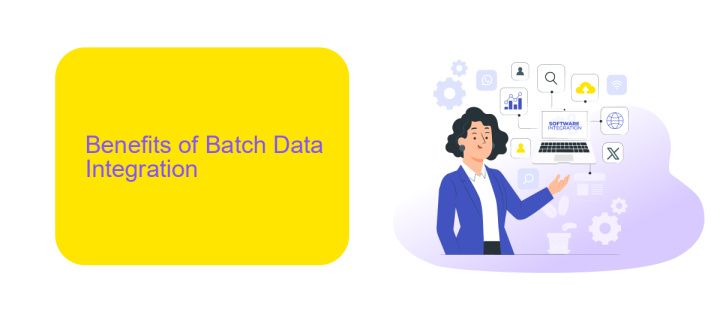Batch Data Integration
Batch Data Integration is a critical process in modern data management, enabling organizations to efficiently handle large volumes of data. By consolidating and processing data in batches, businesses can ensure data consistency, improve performance, and streamline operations. This article explores the key concepts, benefits, and best practices of batch data integration, highlighting its importance in today's data-driven world.
Introduction
Batch data integration is a crucial process for organizations that need to consolidate data from various sources into a single, unified system. This method allows for the efficient handling of large volumes of data, ensuring that information is up-to-date and readily available for analysis and decision-making.
- Improved data consistency and accuracy
- Enhanced data processing efficiency
- Reduced manual data entry and errors
- Better decision-making capabilities
One of the tools that can significantly streamline batch data integration is ApiX-Drive. This service provides an intuitive interface for setting up integrations between different data sources, automating the data transfer process, and ensuring that all data is synchronized correctly. By leveraging such tools, organizations can save time and resources while maintaining high data quality standards.
Benefits of Batch Data Integration

Batch data integration offers numerous benefits, particularly in the realm of data processing efficiency. By consolidating data from various sources into a single batch, organizations can streamline their workflows and reduce the time spent on data handling. This method is highly effective for managing large volumes of data, as it allows for the processing of multiple records simultaneously, thereby enhancing overall productivity. Additionally, batch processing minimizes the risk of data inconsistency and errors, ensuring that datasets remain accurate and reliable.
Another significant advantage of batch data integration is cost-effectiveness. By automating the data integration process, businesses can save on labor costs and reduce the need for manual intervention. Tools like ApiX-Drive facilitate seamless integration by providing a user-friendly platform for configuring and managing data workflows. This service allows organizations to connect various applications and automate data transfers with minimal effort, further optimizing operational efficiency. In essence, batch data integration not only simplifies data management but also contributes to substantial cost savings and improved data quality.
Challenges of Batch Data Integration

Batch data integration presents several challenges that organizations must navigate to ensure seamless data processing and transfer. One of the primary issues is the complexity of managing large volumes of data, which can lead to performance bottlenecks and extended processing times. Additionally, ensuring data accuracy and consistency across multiple sources can be difficult, often requiring extensive validation and error-handling mechanisms.
- Data Volume and Performance: Handling large datasets can strain system resources, leading to slower processing times and potential downtime.
- Data Consistency: Ensuring that data remains consistent and accurate across various sources can be challenging, especially when dealing with disparate systems.
- Scheduling and Coordination: Batch processes need to be carefully scheduled and coordinated to avoid conflicts and ensure timely data integration.
- Error Handling: Robust error-handling mechanisms are essential to identify, log, and rectify issues that arise during the integration process.
To address these challenges, organizations can leverage tools like ApiX-Drive, which simplifies the integration process by providing an intuitive platform for setting up and managing data workflows. This service helps streamline data transfers, ensuring accuracy and minimizing the risk of errors, ultimately enhancing the efficiency of batch data integration.
Best Practices for Batch Data Integration

Effective batch data integration requires careful planning and execution to ensure data accuracy and consistency. One essential practice is to schedule batch processes during off-peak hours to minimize the impact on system performance and availability. This approach helps in managing resource utilization efficiently.
It is also crucial to monitor and validate data integrity throughout the integration process. Implementing automated validation checks can help in identifying discrepancies early, thus preventing potential data issues. Using tools like ApiX-Drive can streamline the integration setup and monitoring, providing real-time insights and alerts.
- Schedule batch processes during off-peak hours.
- Implement automated data validation checks.
- Utilize integration tools like ApiX-Drive for efficient management.
- Regularly review and update integration workflows.
Finally, maintaining comprehensive documentation of the integration workflows and configurations is vital. This practice not only aids in troubleshooting but also ensures that any changes or updates can be implemented smoothly. By adhering to these best practices, organizations can achieve reliable and efficient batch data integration.


Conclusion
In summary, Batch Data Integration is a crucial process for efficiently managing and consolidating large volumes of data from various sources. By implementing batch processing techniques, organizations can streamline data workflows, reduce redundancy, and ensure data consistency. This approach not only enhances operational efficiency but also supports better decision-making by providing timely and accurate data insights.
Furthermore, leveraging tools like ApiX-Drive can significantly simplify the setup and management of data integrations. ApiX-Drive offers a user-friendly interface and robust features that facilitate seamless data transfers between different systems. By automating these processes, businesses can save time and resources, allowing them to focus on strategic initiatives rather than manual data handling. In essence, adopting batch data integration and utilizing advanced integration services can lead to more efficient and effective data management practices.
FAQ
What is Batch Data Integration?
What are the advantages of Batch Data Integration?
How often should batch data integration processes be scheduled?
What tools can be used for implementing Batch Data Integration?
How can I ensure data accuracy in Batch Data Integration?
Do you want to achieve your goals in business, career and life faster and better? Do it with ApiX-Drive – a tool that will remove a significant part of the routine from workflows and free up additional time to achieve your goals. Test the capabilities of Apix-Drive for free – see for yourself the effectiveness of the tool.

